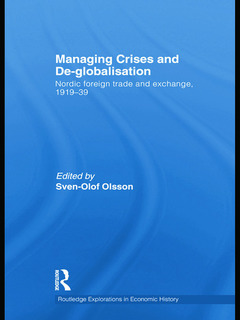Managing Crises and De-Globalisation Nordic Foreign Trade and Exchange, 1919-1939 Routledge Explorations in Economic History Series
Coordonnateur : Olsson Sven-Olof

As small, open economies the Nordic states have always been more dependent on foreign trade than larger powers, and have thus had a historic preference for free trade. But during the inter-war period the Nordic countries were squeezed between powerful and aggressive trading partners: above all Great Britain and Germany. Although the period between the end of the First World War and 1929 was marked by a return to a liberal world economy, the Great Depression ushered in a decade of protectionism. The bilateralisation of international trade was especially evident after Britain?s Ottawa treaties in 1932 and the Nazi seizure of power in 1933. Their dependence on trade with Britain and Germany meant that the Nordic countries were exposed to the full force of British and German bilateralism.
The paradox is that in spite of international trade wars and regulated exchange the Nordic countries managed better than other European states during the interwar period, and that the Great Depression was not as deep or long lasting as in other countries. The chapters in this book discuss why and how this rather successful Nordic experience was achieved. The topics covered include commercial and monetary policies but also important industries such as forestry, agriculture and fishing. Many of the chapters are comparative and discuss economic developments in two or more Nordic countries.
1. Introduction 2. British-German rivalry in Northern Europe revisited Patrick Salmon 3. Nordic trade cooperation in the 1930s Sven-Olof Olsson 4.Why did Norwegian trade become more active in the interwar period? Monica Værholm 5. Effective protection, prices and GDP growth: Tariffs in Finland during the interwar period Jari Kauppila 6. Re-examining Norwegian monetary policy in the 1930s Lars Fredrik Øksendal 7. Danish exchange rate policy and and economic Interest groups: the interwar experience Hans Kryger Larsen 8. Norway’s and Sweden’s bilateral exchange clearing with Germany during the 1930s Peter Hedberg 9. The Scandinavian food system between organisation and state Flemming Just 10. Trade crisis and regulation of the farm sector: Sweden in the interwar years Mats Morell 11. Comparing the Icelandic and Norwegian fisheries’ responses to the economic crisis of the 1930s Guðmundur Jónsson 12. The state and the formation of the fishing industry: Denmark in the interwar period Morten Karnøe Søndergaard 13. Cartels in the Swedish forest industry in the interwar period Birgit Karlsson 14. Big business, market power and small nations: The Norwegian aluminium and nickel industry 1920-39 Pål Sandvik & Espen Storli
Sven-Olof Olsson is Assistant Professor at the Department of Economic History in the Faculty of Social Sciences at Gothenburg University, Sweden.
Date de parution : 06-2014
15.6x23.4 cm
Date de parution : 11-2009
15.6x23.4 cm
Thèmes de Managing Crises and De-Globalisation :
Mots-clés :
Sterling; norwegian; Norwegian Export; exports; IG Farben; nordic; Norwegian Aluminium; countries; Nordic Cooperation; aluminium; Norges Bank; nickel; Smaller Trading Partners; industries; Scandinavian Countries; trade; Ouchy; policy; NOK; international; Sterling Bloc; Formal Tariffs; Held; War Time; Social Liberal Party; Nickel Industries; International Aluminium Company; Capital Intensive Approach; Danish Fisheries; Fisheries Council; Gdp Growth; Aluminium Limited; Gold Bullion Standard; BACO; Fisheries Organisations


